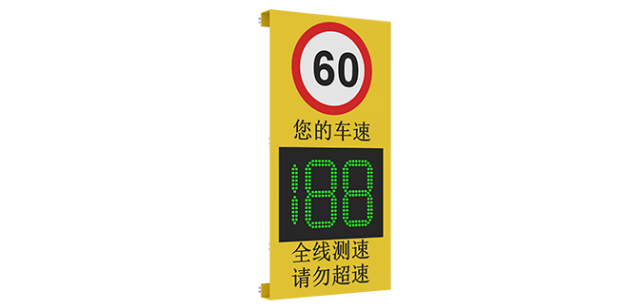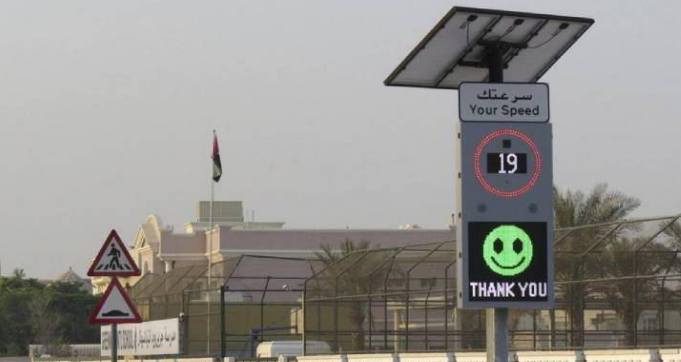A Detail Guide To Radar Speed Signs
Radar speed signs are electronic displays utilizing LEDs to exhibit vehicle speeds as drivers approach. Typically composed of multiple LEDs, these signs actively notify drivers if they exceed the specified speed limit, encouraging them to decelerate. Functioning as part of traffic-calming measures, radar speed signs complement or substitute traditional speed limit signs and road markings, effectively contributing to the regulation of vehicle speeds for safer roads.
How do radar speed signs function?
Radar speed signs operate based on transmitted signals. These signs emit wireless signals and focus on detecting the wireless communications emitted by moving vehicles.
The process involves measuring the time difference between signal transmission and reception by the radar speed signs. This time differential determines the distance between the sign and the vehicle. As the vehicle moves closer or farther away from the sign, the distance changes. By utilizing these varied distances and the displayed speeds on the sign, the vehicle's speed is accurately calculated.
These devices can be programmed to set a minimum speed limit, triggering an alert if a vehicle surpasses this threshold. Some vehicles are also equipped with speed-detecting signs, commonly found on police vehicles or traffic enforcement cars.
Radar speed signs serve as invaluable tools, aiding traffic authorities in enforcement while also assisting drivers in adhering to speed limits. They are increasingly essential in high-traffic or critical areas such as schools, residential areas, hospitals, and other important locations.
Applications of Radar Speed Signs:
Intersection Management:
At major traffic junctions in cities, chaos during rush hours is a common sight. Radar speed signs offer an effective solution to reduce congestion and jams in modern cities. Advanced radar systems provide real-time traffic information, monitoring vehicle distance and speed while guiding all road users towards appropriate routes to alleviate congestion.
Arterial Road Management:
Placing a radar speed sign on arterial roads effectively monitors multi-lane sections, especially beneficial for highways or heavily trafficked thoroughfares. These signs significantly reduce the risk of accidents by offering real-time traffic updates and identifying speeding drivers. Functioning seamlessly in various weather and lighting conditions, they prove highly effective in tunnels and areas with direct sunlight exposure.
Enforcement:
Addressing traffic-related issues due to insufficient personnel is a prevalent challenge on Indian roads. Radar speed signs offer a high degree of accuracy and reliability in managing traffic. These signs assist in catching speeding drivers, enhancing enforcement measures. Placing this technology at junctions or on highways aids in catching offenders engaged in red-light violations, wrong-way driving, or other illegal actions.
Radar Technology for Traffic Applications:
Currently, there are four distinct types of radar speed sign technologies based on their radar capabilities:
1. 1D Radar: Measures only vehicle velocity without object placement, focusing on unidirectional traffic.
2. 2D Radar: Detects velocity and range without pinpointing objects at a distance.
3. 3D Radar: Pinpoints objects in a 2D environment by analyzing speed, range, and angle of movement for vehicles and users.
4. 4D Radar: Checks velocity, range, angle, and elevation, providing precise localization of objects in a 3D environment.
These variations in radar technology cater to different traffic scenarios, enhancing the ability to monitor and manage roadways effectively.
Advantages of Utilizing Radar Speed Signs for Speed Control:
Radar speed signs offer several notable advantages, foremost among them being their efficacy in curbing speeding behaviors. Research has consistently demonstrated that drivers tend to decelerate upon seeing their speed prominently displayed on these signs. This behavior adjustment significantly contributes to enhancing road safety and mitigating the likelihood of accidents.
Moreover, radar speed signs boast easy installation and maintenance processes, adding to their appeal as a speed control solution. They are programmable, allowing for the display of varied messages based on the time of day or specific requirements of the area. This adaptability ensures their suitability for addressing diverse speed management needs efficiently.
Disadvantages of using radar speed signs for speed control
Despite the numerous advantages offered by radar speed signs for speed control, there are several potential drawbacks that warrant consideration. One primary concern is the risk of drivers overly relying on these signs, potentially overlooking crucial factors like road conditions or pedestrian presence. Additionally, there's the possibility that some drivers might disregard the signs entirely or, worse, view them as a challenge to test their speed limits. Lastly, the cost of purchasing and maintaining radar speed signs could pose a financial hurdle for certain communities or organizations, making their implementation less feasible.
Alternatives to radar speed signs for speed control.
There are alternative approaches to speed control besides radar speed signs, each offering its own set of advantages and drawbacks. Methods such as speed humps, roundabouts, and traffic circles serve as viable alternatives. The effectiveness of each method depends on the unique road and traffic conditions. For instance, speed humps might effectively reduce speeds on residential streets, while roundabouts could be more suitable for managing traffic at busy intersections. Careful consideration of these options is crucial to determine the most fitting approach for a specific situation.










Leave a comment